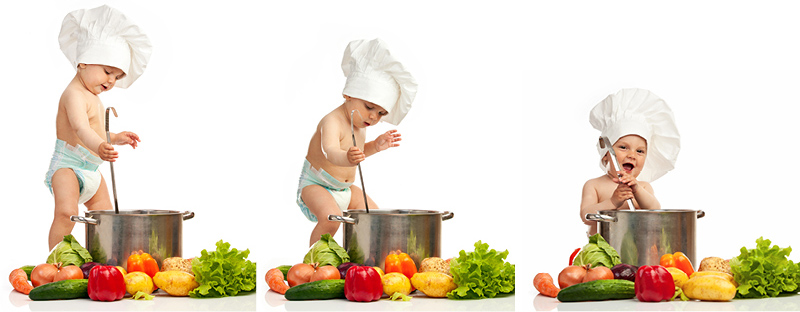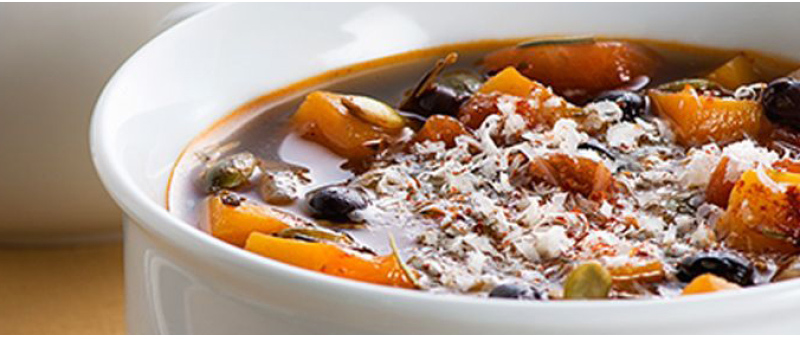Soup’s On!

Soups! Enjoyed at any age and are as much fun to make as they are to eat.
With the flip of the calendar, it’s Fall – in all its glory. Around here, that means brilliant outdoor colors, breaking out the sweaters, an extra blanket for chilly nights, and my favorite … soup! This means all kinds of soups! It’s the time of year when we spend less time grilling and more time hovered over a steamy hot bowl of soup (crackers and cheese and lots of black pepper of course). Jackie has so many incredible recipes. With the help of the internet, I found this link at Ready, Set, Eat – and just listen to some of these names: slow cooker butternut squash & sausage, white bean and kale minestrone, wagon wheel turkey vegetable, southwestern creamy chicken, ramen noodle (brings back memories of younger days! and mushroom … oh yea – Now to be perfectly honest, I will / would not be allowed to partake in some of the above soups…unless someone wants a temporary house guest! Be sure to pick a few and give them a try – or better yet, if you have a family favorite, email it to me at skowalski@khtheat.com so I can enjoy as well. Here’s a little soup trivia, some different soups from around the world and a yummy recipe. Enjoy!!
- Evidence of the existence of soup can be found as far back as about 20,000 BC. Boiling was not a common cooking technique until the invention of waterproof containers (which probably came in the form of clay vessels). Animal hides and watertight baskets of bark or reeds were used before this. To boil the water hot rocks were used. This method was also used to cook acorns and other plants.
- The word soup comes from French soupe (“soup”, “broth”), which comes through Vulgar Latin suppa (“bread soaked in broth”) from a Germanic source, from which also comes the word “sop”, a piece of bread used to soak up soup or a thick stew.
- The word restaurant (meaning “[something] restoring”) was first used in France in the 16th century, to refer to a highly concentrated, inexpensive soup, sold by street vendors, that was advertised as an antidote to physical exhaustion. In 1765, a Parisian entrepreneur opened a shop specializing in such soups. This prompted the use of the modern word restaurant for eating establishments.
- In the US, the first colonial cookbook was published by William Parks in Williamsburg, Virginia, in 1742, based on Eliza Smith’s The Complete Housewife; or Accomplished Gentlewoman’s Companion, and it included several recipes for soups and bisques. A 1772 cookbook, The Frugal Housewife, contained an entire chapter on the topic.
- English cooking dominated early colonial cooking; but as new immigrants arrived from other countries, other national soups gained popularity. In particular, German immigrants living in Pennsylvania were famous for their potato soups. In 1794, Jean Baptiste Gilbert Payplat dis Julien, a refugee from the French Revolution, opened an eating establishment in Boston called “The Restorator”, and became known as the “Prince of Soups”.
- The first American cooking pamphlet dedicated to soup recipes was written in 1882 by Emma Ewing: Soups and Soup Making.
- Portable soup was devised in the 18th century by boiling seasoned meat until a thick, resinous syrup was left that could be dried and stored for months at a time. Commercial soup became popular with the invention of canning in the 19th century, and today a great variety of canned and dried soups are on the market.
- Doctor John T. Dorrance, a chemist with the Campbell Soup Company, invented condensed soup in 1897. Canned soup can be condensed, in which case it is prepared by adding water (or sometimes milk), or it can be “ready-to-eat”, meaning that no additional liquid is needed before eating. Condensing soup allows soup to be packaged into a smaller can and sold at a lower price than other canned soups.
- Today, Campbell’s Tomato (introduced in 1897), Cream of Mushroom, and Chicken Noodle (introduced in 1934) are three of the most popular soups in America. Americans consume approximately 2.5 billion bowls of these three soups alone each year.
- In French cuisine, soup is often served before other dishes in a meal. In 1970, Richard Olney gave the place of the entrée in a French full menu: “A dinner that begins with a soup and runs through a fish course, an entrée, a sorbet, a roast, salad, cheese and dessert, and that may be accompanied by from three to six wines, presents a special problem of orchestration”.
- “From soup to nuts” means “from beginning to end”, referring to the traditional position of soup as the first course in a multi-course meal. “In the soup” refers to being in a bad situation. “Tag soup” is poorly coded HTML.

Test your knowledge – here are some of my favorites and some that I will be trying in the future:
- Chè– a Vietnamese cold dessert soup containing sugar and coconut milk, with many different varieties of other ingredients including taro, cassava, adzuki bean, mung bean, jackfruit, and durian
- Ginataan– a Filipino soup made from coconut milk, milk, fruits and tapioca pearls, served hot or cold
- Shiruko– a Japanese azuki bean soup
- Sawine– a soup made with milk, spices, parched vermicelli, almonds and dried fruits, served during the Muslim festival of Eid ul-Fitr in Trinidad and Tobago
- Salmorejo– a thick variant of gazpacho originating from Andalusia
- Asopao– a rice soup very popular in Puerto Rico. When prepared with chicken, it is referred to as asopao de pollo
- Bánh canh– a Vietnamese udon noodle soup, popular variants include bánh canh cua (crab udon soup), bánh canh chả cá (fish cake udon soup)
- Bouillabaisse– a fish soup from Marseille, is also made in other Mediterranean regions; in Catalonia it is called bullebesa
- Cazuela– a Chilean soup of medium thick flavored stock obtained from cooking several kinds of meats and vegetables mixed together
- Clam chowder– is found in two major types, New England clam chowder, made with potatoes and cream, and Manhattan clam chowder, made with a tomato base
- Egg drop– a savory Chinese soup, is made by adding already-beaten eggs into boiling water or broth
- Egusi– a traditional soup from Nigeria, is made with vegetables, meat, fish, and balls of ground melon seed. It is often eaten with fufu
- Gumbo– a traditional Creole soup from the Southern United States. It is thickened with okra pods, roux and sometimes filé powder
- Kuy teav(Vi: hủ tiếu) – a Cambodian/Southern Vietnamese pork rice noodle soup, often in combination with shrimp, squid and other seafood, topped with fresh herbs and bean sprouts
- Kyselo– a traditional Bohemian (Krkonoše region) sour soup made from sourdough, mushrooms, cumin, potatoes and scrambled eggs
- Lagman– a tradition in Uzbekistan, is made with pasta, vegetables, ground lamb and numerous spices
- Mulligatawny– is an Anglo-Indian curried soup
- Nässelsoppa(nettle soup) – is made with stinging nettles, and traditionally eaten with hard boiled egg halves, is considered a spring delicacy in Sweden
- Nkatenkwan – a heavily spiced soup from Ghana based on groundnut with meat, most often chicken and vegetables added
- “Peasants’ soup”– a catch-all term for soup made by combining a diverse—and often eclectic—assortment of ingredients. Variations on peasants’ soup are popular in Eastern Europe, Russia, and Central Africa
- Scotch broth– is made from mutton or lamb, barley and root vegetables
- Snert(erwtensoep) – a thick pea soup, is eaten in the Netherlands as a winter dish, and is traditionally served with sliced sausage. (“Jackie – more snert please”)
- Soupe aux Pois Jaunes– a traditional Canadian pea soup that is made with yellow peas and often incorporates ham
- Svartsoppa– is a traditional Swedish soup, whose main ingredient is goose and, sometimes, pig’s blood, and is made in Skåne, the southernmost region of Sweden. The other ingredients typically include vinegar, port wine or cognac and spices such as cloves, ginger and allspice. The soup is served warm with boiled pieces of apple and plums, goose liver sausage and the boiled innards of the goose. (“Jackie – I’m good…no more goose innards…”)
- Tarhana– is from Persian cuisine and is made with fermented grains and yogurt
- Mirepoix– consists of carrot, onion and celery and is often used for soup stocks and soups

Savory Black Bean Pumpkin (A MUST TRY!)
- 3 15 oz. cans of black beans, rinsed and drained
- 1 14.5 oz. can of diced tomatoes
- ¼ cup olive oil
- 1-2 cups chopped onions
- 4 cloves of garlic, chopped
- 1 tsp. sea salt
- ½ tsp. black pepper
- 4 cups organic chicken broth
- 1 15oz. can of pumpkin puree
- ½ tsp. allspice
- 1 tsp. chili powder
- 1 tsp. cumin
- Fresh cilantro and plain Greek yogurt for garnish
- Saltines or favorite soup crackers
Drain 2 cans of black beans and pour into food processor along with tomatoes. Puree. Set aside.
Heat oil in soup pot over medium heat. Add onion and garlic and season with salt and pepper. Cook and stir onions until softened. Stir in bean puree, remaining can of beans, chicken broth, pumpkin puree, allspice, chili powder and cumin. Mix until well blended, then simmer for about 25 minutes. Serve hot, sprinkle with cilantro garnish, dollop of yogurt and crackers.



Leave a Reply
Want to join the discussion?Feel free to contribute!